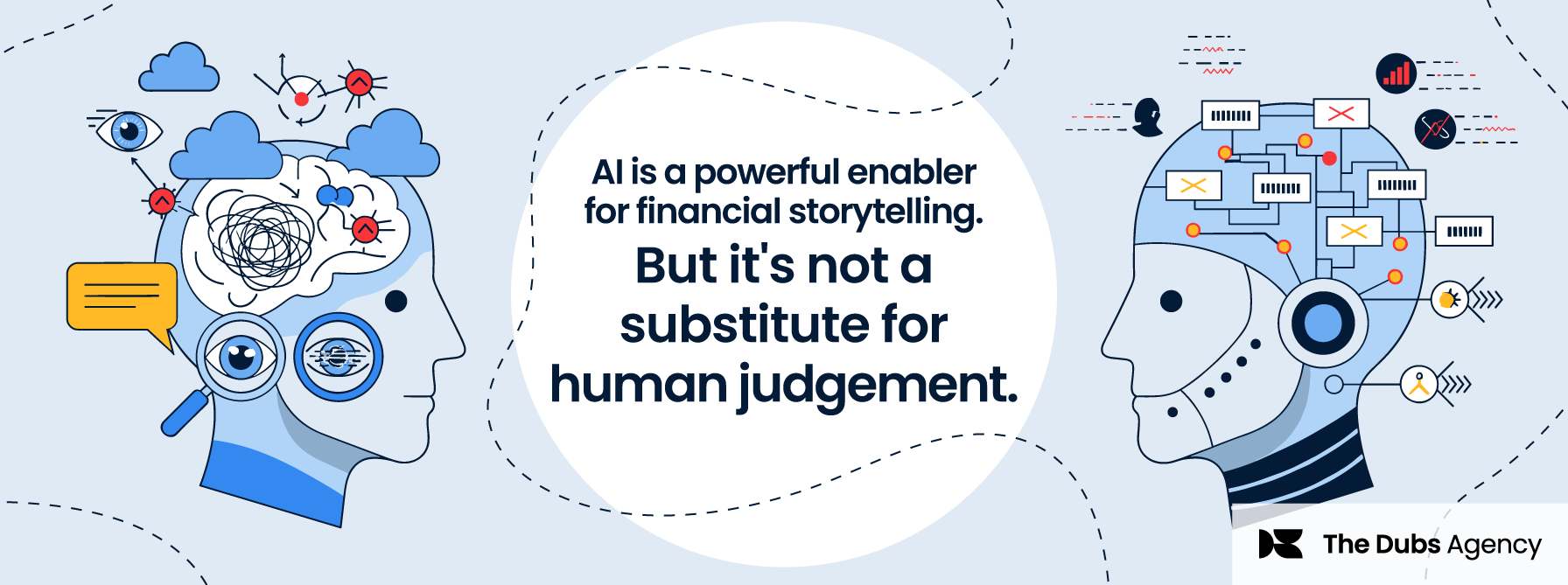Financial storytelling is the art of using data, narrative, visualisation and context to make financial results, forecasts and strategy understandable and compelling. In a world awash with data, many organisations are exploring how artificial intelligence (AI) might enhance or even automate parts of that storytelling. But AI isn’t a magic wand: it has strengths, constraints, and risks.
In this article, we’ll explore:
-
The promise and current adoption of AI in finance
-
What parts of storytelling AI already handles well
-
What it struggles with (and often fails)
-
Strategic guidelines and guardrails
AI in finance
Before diving into storytelling, it helps to understand where AI has already taken root in finance, because storytelling builds on those foundations.
-
According to NVIDIA’s State of AI in Financial Services survey, 43% of respondents already use generative AI in their organisations.
-
A KPMG global study of ~2,900 finance executives found many are rolling out AI across accounting, planning, treasury, risk and tax operations.
-
All About AI reports the global AI in finance market is estimated at USD 38.36 billion, with forecasts suggesting it could reach USD 190 billion by 2030.
These numbers show that AI is no longer hypothetical in finance, it’s increasingly operational. But most adoption to date is in back-office, pattern recognition, anomaly detection, forecasting, and document processing rather than full narrative creation.
What AI can do for financial storytelling
Here are areas in the storytelling pipeline where AI is already quite capable and where it adds genuine value:
1. Data ingestion, structuring & anomaly detection
One of the unglamorous but crucial steps in storytelling is preparing the raw financial data: cleaning, aggregating, ensuring consistency, flagging anomalies or outliers. A.I. (especially machine learning models) excel at pattern detection, outlier identification, consolidation across data sources, and detecting correlations that might be non-obvious.
2. Draft narrative / first pass commentary
Generative AI can transform processed financial data (e.g. revenue by segment, margins over time, variance from budget) into narrative text. For example, it can write a first-draft “management commentary” or “insight summary” that says: “Segment A’s margin contraction in Q2 was largely driven by input cost inflation, partially offset by higher volume in Region X …”
KPMG notes that generative AI, combined with finance, “can create better speed and efficiency by eliminating redundant or manual activities, allowing finance professionals to focus on higher-value tasks”, though “it is only as good as the underlying data and well-engineered prompts.”
3. Visualisation & adaptive charts
AI tools can suggest optimal chart types, build dynamic visuals, or even animate transitions. Some platforms can auto-select chart frames, colour schemes, or overlays (e.g. revenue trend + benchmark). These visuals support the narrative by making data more digestible and engaging.
4. Text-to-video & multimodal storytelling
The newer frontier: converting narrative and visuals into short videos or animated summaries. Platforms like Mootion the “AI financial explainer video maker” help turn complex financial concepts, investment strategies, wealth-management advice and personal-finance topics into video stories, combining chart animation, voiceover, scene transitions and narrative text. As video becomes more consumed in finance communications, social media, or internal updates, this capability is significant.
In fact, as Finextra reports UBS has begun deploying AI-generated avatars of its analysts to deliver video research content to clients, scaling video production while freeing analysts to focus on deeper insights.
5. Personalisation & scenario variants
Because AI is programmable, it can generate variant narratives tailored to different audiences (e.g. investors vs operations) or scenarios (optimistic, base, downside). It can also more easily produce “what-if” or scenario-driven storylines by combining data inputs with narrative templates.
What AI Can’t (or doesn’t reliably) do yet
While expectations are high, there remain several limitations, risks, and failures that financial storytellers should be wary of:
1. Deep domain insight, judgment & nuance
Financial storytelling often hinges on domain understanding, intuition, subtlety, and judgment calls (e.g. regulatory implications, market sentiment, qualitative drivers). AI can suggest patterns, but cannot reliably substitute for an expert’s interpretive reasoning. It may miss counterintuitive insights or over-emphasise correlations that lack causal basis.
2. Contextual consistency over long narratives
AI may produce internally inconsistent narratives, especially over longer explanations (e.g. repeating contradictory statements, drifting focus). Ensuring logical narrative flow, contextual coherence, or a crisp “through-line” in longer documents remains challenging for many generative models.
3. Handling ambiguous, conflicting or missing data
When data is incomplete, contradictory, or ambiguous, A.I. struggles. It may attempt to hallucinate or smooth over gaps, potentially generating misleading statements. Human oversight is required to vet and correct.
4. Creativity, metaphor, tone & audience empathy
Storytelling is also about voice, emotion, resonance. AI generally lacks true creativity, empathy or deep sense of audience feedback. It may write pedestrian statements or fail to tailor tone dynamically. The “human edge” intuition, rhetorical framing, emotional resonance remains a competitive differentiator.
As Scott Winters, puts it in this Financial Gravity article
“ Empathy and storytelling – not automation will define the next generation of great financial advisors. ”
5. Bias, error, hallucinations & overconfidence
Generative models can hallucinate facts, misstate numbers, invent references, or misinterpret prompt context. Unless constrained carefully, these outputs risk inaccuracy or misleading claims. Rigorous validation, guardrails, and fact-checking remain essential.
6. Governance, auditability & compliance
In regulated financial environments, story content (especially forward-looking statements or risk disclosures) must be auditable and defendable. A.I. models often operate as “black boxes.” Ensuring traceability (which data used, which prompt, who edited) is a complex but necessary requirement for responsible use.
7. Visual / video limits
Although AI video generation is advancing, there are limits: high resolution, long-form coherence, facial realism, lip-sync accuracy, audio synchronisation and contextual transitions remain challenging. Text-to-video models are computationally intensive, limited in output length, and prone to artifacts.
Strategic guidance & best practices
Here are the principles and guardrails for integrating A.I. into your financial storytelling workflow:
| Guiding Principle | What It Means in Practice |
|---|---|
| Human-in-the-loop | Always involve human review, editing and oversight of AI drafted narratives. |
| Validate & audit | Maintain traceability: record input data, prompts, edits, final version. |
| Start with templates / scaffolding | Use prompt templates or narrative frameworks rather than raw prompts. |
| Limit domain scope initially | Begin with narrow modules (e.g. commentary on margin or variance) before full reports. |
| Define tone, audience, constraints | Be explicit about style, complexity, disclaimers, compliance rules. |
| Monitor and iterate | Track discrepancies, error types, user feedback, and retrain or refine models. |
| Blend modalities wisely | Use video or animations for summary or engagement—but retain textual or PDF versions. |
| Educate users and consumers | Disclose when a narrative is assisted by AI or partially generated (transparency builds trust). |
KPMG emphasises that generative AI’s effectiveness depends heavily on “well-engineered prompts” and robust embedding into finance workflows.
What the future looks like
-
Multimodal models are advancing: systems like MAViS or MM-StoryAgent research projects attempt to coordinate script writing, visuals, character modelling and audio in unified storytelling pipelines.
-
Text-to-video models like Veo (from DeepMind Google) are evolving to support longer content with improved audio/video sync.
-
More financial institutions will adopt hybrid avatars (as with UBS), enabling scalable video research and narration.
-
The frontier will shift from “drafting commentary” to “interactive, live narrative agents” (e.g. investor dashboard that tells evolving stories in real time).
-
Regulation, explainability, bias controls, and domain certification will become prerequisites for adoption in regulated settings.
AI is a powerful enabler in the financial storytelling toolkit, accelerating data work, drafting commentary, generating visuals, and even producing short video stories. But it is not a substitute for the human judgment, domain nuance, narrative sense, and accountability that financial storytelling demands.
The ideal path is augmentation, not replacement: let AI handle repetitive or structured tasks, while human experts refine, validate, add insight, tone and integrity. With disciplined guardrails, iterative adoption, and transparency, AI can amplify storytelling reach without compromising trust.
If you enjoyed this article and would like to know more contact The Dubs Agency we’d love to help.
[For full disclosure: The author used Perplexity to research this article while the podcast was created using ElevenLabs]










